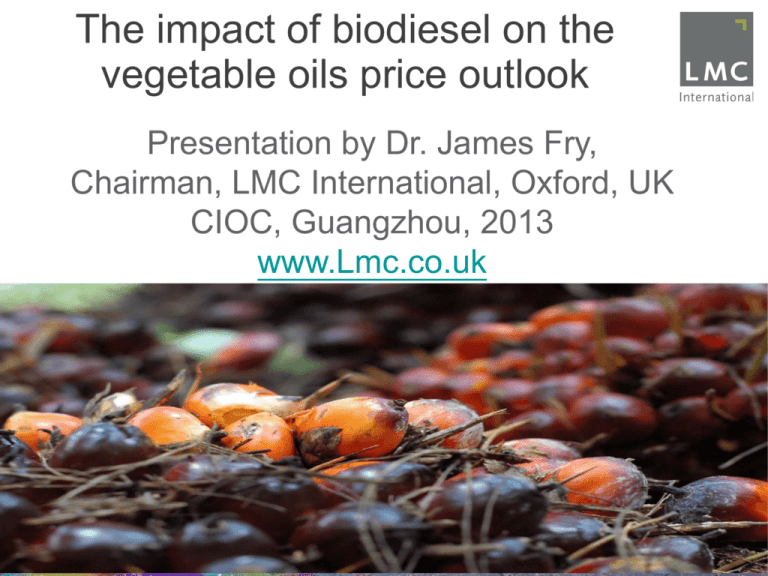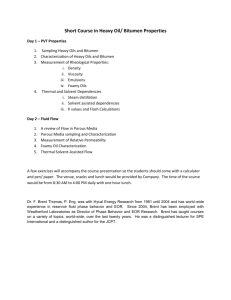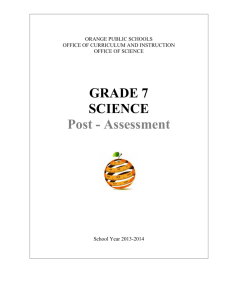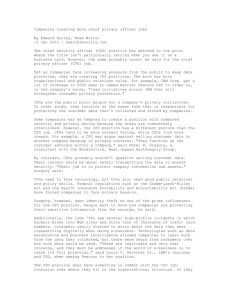
The impact of biodiesel on the
vegetable oils price outlook
Presentation by Dr. James Fry,
Chairman, LMC International, Oxford, UK
CIOC, Guangzhou, 2013
www.Lmc.co.uk
Background to my presentation
• The oilseeds complex is complicated, thanks to the
interaction between the oils and meals sectors. Since
biofuels only affect oils, I will not discuss meal, but will
concentrate on the forces determining vegetable oil
prices today, which will highlight the role of biofuels.
• The 12 months since we last met have been the most
remarkable “laboratory” for testing the validity of the
price band linking vegetable oil prices to petroleum.
• A year ago, palm oil stocks were at all-time highs. The
world was anticipating record S. American soy crops.
• No wonder most people were bearish for 2013, but I
hope to explain why my belief in the price band in the
face of its greatest ever test has been fully vindicated.
How has the price band been behaving?
This is my favourite diagram. It shows how EU oils
and petroleum prices have been linked since 2007
in a price band, which has survived its major test.
NW Europe prices, US$ per tonne
1,600
1,400
1,200
1,000
800
600
400
200
Jan-06
Jan-07
Jan-08
Brent Crude
Jan-09
Palm Oil
Jan-10
Jan-11
Soy Oil
Jan-12
Jan-13
Rapeseed Oil
Because of the price band, we should now focus
on EU spreads over Brent crude inside the band.
EU premium over Brent crude, US$/tonne
800
700
600
500
400
300
200
100
0
-100
Jan-07
CPO
Jan-08
SBO
Jan-09
RSO
Jan-10
CPO Average
Jan-11
Jan-12
SBO Average
Jan-13
RSO Average
September was the third time that the premium
for CPO fell to zero, i.e., the EU CPO price was
equal to the Brent North Sea crude oil price.
EU premium over Brent crude, US$/tonne
800
700
600
500
400
300
200
100
0
-100
Jan-07
CPO
Jan-08
SBO
Jan-09
RSO
Jan-10
CPO Average
Jan-11
Jan-12
SBO Average
Jan-13
RSO Average
Since 2007, vegetable oil prices behave as
if they are part of the petroleum complex.
• The main oils now trade inside a cage that links them to
petroleum prices. Brent North Sea crude is the one we
use, as it is the price reference for most world trade.
• Brent crude sets the floor to the price band, while palm
is the oil whose price trades the closest to this floor.
• The CPO price floor, which is where EU palm oil prices
equal Brent crude prices, was tested to the extreme just
after last year’s CIOC and it has been tested again in
the past three months, but once again it held firm.
• In the rest of my talk, I will explain why the price band
has been so resilient and what this means for the future.
What determines the premium for
vegetable oils over Brent crude?
600
2,750
500
2,500
400
2,250
300
2,000
200
1,750
100
1,500
0
1,250
-100
Jan-07
1,000
Jan-08 Jan-09
Premium
Jan-10 Jan-11 Jan-12
Average premium
Jan-13
Stocks
MPOB Stocks, '000 tonnes
EU premium over Brent, $/tonne
Answer for palm oil: its premium vs. Brent moves
in the opposite direction to Malaysian stocks.
Since 2007, Brent crude oil has set the floor to
EU CPO prices. Malaysian Palm Oil Board data
on stocks drive the CPO premium over Brent.
• Brent crude prices lie at the bottom of the price band.
• Malaysian palm oil stocks are crucial in determining
the level of the EU premium for CPO over Brent prices.
• High stocks have been associated with a low premium;
and low MPOB stocks with a high premium.
• Did you notice that something has changed recently?
• The market has started to be forward-looking and the
premium has started to anticipate stock changes. The
premium tumbled before stocks rose, and then in the
past month, the premium soared before stocks fell.
• (To be honest, it is remarkable it has taken so long for
the seasonality of CPO output to be recognised.)
I mentioned seasonality because the monthly
pattern of Malaysian CPO output is very regular,
with the monthly peak just before the year-end.
2.0
Monthly CPO output, million tonnes
1.9
1.8
1.7
1.6
1.5
1.4
1.3
1.2
1.1
1.0
2009
2010
2011
2012
2013
How does the CPO price floor hold firm
in the face of the pressure of stocks?
At the zero premium floor to the EU price band,
CPO in S.E. Asia is cheaper than Brent. See EU
(red) and Malaysian (blue) premia over Brent.
CPO premium over Brent, US$ per tonne
250
200
150
100
50
0
-50
-100
-150
-200
03/09/12
03/11/12
03/01/13 03/03/13
CPO Cif Rott
03/05/13
03/07/13
CPO Local Delivered
03/09/13
03/11/13
In Indonesia export taxes pull local CPO prices
(green) down to a bigger discount to Brent than
those at a FOB level for exports (in blue).
CPO premium over Brent, US$ per tonne
250
200
150
100
50
0
-50
-100
-150
-200
-250
03/09/12
03/11/12
Cif Rott
03/01/13
03/03/13
FOB Belawan
03/05/13
03/07/13
03/09/13
FOB Belawan - export tax
03/11/13
Indonesian export taxes make local CPO (green)
and stearin prices (red) very similar. Therefore
biodiesel for local use is often made from stearin.
Premium over Brent, US$ per tonne
50
0
-50
-100
-150
-200
-250
03/09/12
03/11/12
03/01/13 03/03/13
CPO f.o.b - Export tax
03/05/13
03/07/13
03/09/13
RBD Stearin f.o.b - Export tax
03/11/13
Freight costs and export taxes have
defended the floor to the EU price band
• Freight costs from S.E. Asia translate the floor to the EU
price band (where CPO prices equal Brent crude prices)
into an FOB CPO discount on crude oil in S.E. Asia.
• Export taxes in S.E. Asia have reinforced the economics
of turning CPO into biofuel for use in the region.
• There is no doubt that, at the floor to the price band,
vegetable oils are competitive liquid fuels in S.E. Asia.
• However, the big increase just announced in Indonesia’s
biodiesel mandate has added $120 to the CPO price.
• In the first week of October, internal Indonesian CPO
prices were $105 below Brent crude. In the first week of
November, they had leapt to $15 above Brent.
If palm oil producers have been the
winners, who have been the losers?
The main losers are the seed oils. As EU and US
support for biofuels has eased, seed oils look to
strong CPO prices to underpin their own prices.
Premium over Brent, US$ per tonne
600
500
400
300
200
100
0
-100
03/09/12
03/11/12 03/01/13 03/03/13
Soy oil
Palm oil
03/05/13 03/07/13 03/09/13
Rapeseed oil
Sun oil
03/11/13
Another group of losers as a result of Indonesian
export taxes has been importing refiners. CIF
CPO prices are often above those of RBD olein.
EU premium over Brent, US$ per tonne
250
200
150
100
50
0
-50
-100
-150
03/09/12
03/11/12
CPO
03/01/13
03/03/13
03/05/13
RBD P.Stearin
03/07/13
03/09/13
RBD P.Olein
03/11/13
This is possible because Indonesian export taxes
on olein are lower than those on CPO, pulling
olein prices above CPO prices inside Indonesia.
Premium over Brent, US$ per tonne
100
50
0
-50
-100
-150
-200
-250
03/09/12
03/11/12
03/01/13
Indonesia CPO
03/03/13
03/05/13
Indonesia Stearin
03/07/13
03/09/13
Indonesia Olein
03/11/13
Seed oil prices are boosted by CPO export
taxes, but destination refiners suffer
• The prices of soy, rapeseed and sunflower oils would all
be lower if it had not been for the support they received
from lower palm oil stocks, which are a direct result of
the stimulus to Asian biofuel demand from export taxes.
• Without palm oil prices as support, seed oil prices would
have started to fall to levels that trigger their own pricesensitive biofuel demand in competition with petroleum.
• It should be stressed that the boost to palm oil offtake in
biofuels has not been at the expense of seed oil sales.
• The main losers from the differential export taxes in S.E.
Asia (higher taxes on CPO than RBD oils) have been the
import refiners; hence the lobbying by Indian refiners for
an increase in the import tariff on RBD palm olein.
How are biofuel policies evolving - US?
The US ran into an ethanol blend wall, making
it impossible to meet renewable fuel mandates.
As they are cut back, biodiesel will suffer, too.
23
Billion gallons
21
19
17
E10 blend wall
15
13
11
9
2008
2009
2010
2011
2012
2013
2014
2015
2016
Corn Ethanol Advanced (i.e. Sugar Ethanol) Cellulosic (Ethanol) Biodiesel
How are biofuel policies evolving - EU?
EU political support for biofuels is falling, causing
a cutback in EU targets; and the “double counting
of waste oils” is hitting its biofuel demand for oils.
Million tonnes of biodiesel demand
14
12
10
8
6
4
2
0
2007
2008
Vegetable oils
2009
'Waste oils'
2010
2011
2012
Double counted & so not used
2013
Weakening EU and US enthusiasm for
biofuels will not end the price band
• Different reasons (technical and political) lie behind the
slowdown or fall in biofuel demand in the US and EU.
• However, this coincides with a sharp rise in S.E. Asian
biodiesel demand, led by Indonesia, and the emergence
of a new form of demand for biodiesel as a cheap fuel in
Asia in imports of biodiesel-diesel blends into China.
• Therefore, the geographical balance of biofuel demand
is shifting, but changing government policies on biofuels
will not affect the future relevance of the price band.
• The scope to use palm oil as a cheap fuel is now well
known. That knowledge is just as relevant for the seed
oils; therefore, every time prices approach that of crude
oil, free market biofuel use should create the price floor.
Price influences in the next few months
The price band, biofuel policies and palm
oil stocks will remain the key to oil prices
• The price band will not go away. Now that the world
knows of the ability to turn oils into biofuels when it
is profitable to do so, that knowledge will not vanish.
• However, biofuel policy can play an important role,
boosting demand (as in S.E. Asia next year) or
slowing it (as in the EU and US), which will affect
the position of individual oils inside the price band.
• As a result, there will be a difference between the
prospects for palm oil, whose stocks are peaking
far below the level in 2012, and the seed oils, which
cannot look to biofuel mandates to take more oil.
• This all points to a narrower spread between palm
oil and seed oils, such as we last saw in 2010.
Implications for future vegetable oil prices
• New crude oil supplies and rising competition from
shale gas still convince me that Brent prices will decline;
but these forecasts apply today’s Brent prices of $106.
• 1. EU CPO prices will move towards $200 above Brent
at $975 in March-April. This implies Malaysian BMD
futures at $850 (M$2,700 at M$3.16/US$).
• 2. CPO would be higher if weak biodiesel demand were
not holding back seed oil prices; but markets work, and
low EU palm-soy spreads, now only $70, will lead some
Chinese and Indian food demand to switch to seed oils.
• 3. This implies EU soy oil should be at $1,050 in April.
• 4. FOB Argentina SBO prices will be $990 vs. FOB
olein at $900 (pulled down by the impact of export
taxes).
•
•
•
•
Thank You
www.LMC.co.uk
Acknowledgements: EIA, IMF, Jacobsen, MPOB,
Public Ledger, SEA (India), TNS, USDA, World Bank
Oxford (HQ)
Clarendon House
52 Cornmarket Street
Oxford OX1 3HJ
UK
New York
1841 Broadway
New York, NY 10023
USA
T +44 1865 791737
F +44 1865 791739
info@lmc.co.uk
T +1 (212) 586-2427
F +1 (212) 397-4756
info@lmc-ny.com
Kuala Lumpur
B-03-19, Empire Soho
Empire Subang
Jalan SS16/1, SS16
47500 Subang Jaya
Selangor Darul Ehsan
Malaysia
T +603 5611 9337
Singapore
16 Collyer Quay, #21-00
Singapore
T +65 6818 9229
+65 6818 9230
+65 6818 9231
info@lmc-kl.com
info@lmc-sg.com
© LMC International, 2013
All rights reserved
This presentation and its contents are to be held confidential by the client, and are not to be disclosed, in whole or in
part, in any manner, to a third party without the prior written consent of LMC International.
While LMC has endeavoured to ensure the accuracy of the data, estimates and forecasts contained in this presentation,
any decisions based on them (including those involving investment and planning) are at the client’s own risk.
LMC International can accept no liability regarding information analysis and forecasts contained in this presentation.





